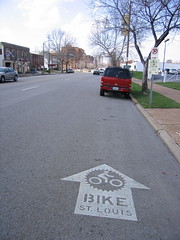New traffic engineering manual approved, including sharrows
The new version of the Manual on Uniform Traffic Control Devices (MUTCD) has been release
d--after many years of work and at least two years of anticipation.
(The draft of the chapter of bicycle facilities has been essentially complete and circulating since at least 2007--apparently technical issues in other sections of the manual caused the delay in final publication.)
The most significant change for bicyclists is the manual officially approves the use of "shared lane markings" or "sharrows".
Many cities--including Columbia and St. Louis--have been trying out the sharrow markings but in the past such cities have had to get special permission from the Federal Highway Administration to use the markings on an experimental basis.
Now that they are approved in the MUTCD, any city or jurisdiction can use the markings and you can expect them to become far more common in cities around the U.S.
Part 9 of the MUTCD (PDF file) deals with bicycle facilities. The section about sharrows is near the end of that section. Here is the relevant information:
The Shared Lane Marking shown in Figure 9C-9 may be used to:
A. Assist bicyclists with lateral positioning in a shared lane with on-street parallel parking in order to reduce the chance of a bicyclist?s impacting the open door of a parked vehicle,
B. Assist bicyclists with lateral positioning in lanes that are too narrow fo r a motor vehicle and a bicycle to travel side by side within the same traffic lane,
C. Alert road users of the lateral location bicyclists are likely to occupy within the traveled way,
D. Encourage safe passing of bicyclists by motorists, and
E. Reduce the incidence of wrong-way bicycling.
Guidance:
The Shared Lane Marking should not be placed on roadways that have a speed limit above 35 mph.
Standard:
Shared Lane Markings shall not be used on shoulders or in designated bicycle lanes.
Guidance:
If used in a shared lane with on-street parallel parking, Shared Lane Markings should be placed so that the centers of the markings are at least 11 feet from the face of the curb, or from the edge of the p avement where there is no curb. If used on a street without on-street parking that has an outside travel lane that is less than 14 feet wide, the centers of the Shared Lane Markings should be at least 4 feet from the face of the curb, or from the edge of the pavement where there is no curb. If used, the Shared Lane Marking should be placed immediately after an intersection and spaced at intervals not greater than 250 feet thereafter.
Option:
Section 9B.06 describes a Bicycles May Use Full Lane sign that may be used in addition to or instead of the Shared Lane Marking to inform road users that bicyclists might occupy the travel lane.
- News
- 2007
- 2009
- about
- accident
- accomplishments
- bicycle
- bicycle facilities
- bicycle lanes
- bicycles
- bicycling
- bicyclist
- bicyclists
- city
- columbia
- engineering
- fhwa
- issues
- missouri bicycle federation
- mobikefed
- parking
- photos
- safe passing
- sharrow
- shoulders
- speed
- traffic
- used
- wrong-way
- wrongway
- Lane
- Lane Marking
- Lane Markings
- Manual on Uniform Traffic Control Devices
- Road transport
- Segregated cycle facilities
- Shared lane marking
- St. Louis
- Street
- Traffic
- Traffic signs
- Transportation engineering
- Transportation in the United States
- Types of roads
- Vehicular cycling
Join MoBikeFed's Advocacy Network
Working together we make a real difference! Join our advocacy network:
Related pages
Current topics...
Archives...
Want better bicycling and walking in Missouri?
We rely on the support of members like you. Please join, renew, or donate today.
- Home
- JOIN/DONATE
- News/Info
- Missouri Bicycling, Running, Trails
- Bicycle Skills and Safety
- Missouri Bike/Ped Law
- Clubs and Organizations
- Bike Shops
- Running Shops
- Bicycling, Running, Trails-related Businesses
- Ride, Run, Walk, Hike, Triathlon, and Events Calendars
- Bicycles on Amtrak
- Maps and Routes
- Trails and Trail Maps
- IBikeMO.org
- Planning a Missouri bicycle trip
- Gravel and Bikepacking Maps & Routes
- Bicycle & Touring Routes
- Advocacy
- Campaigns
- Our Legislative Platform
- Complete Streets
- Statewide Rock Island Trail
- Statewide Trail Vision - Quad State Trail
- Bicycle Friendly Missouri
- Walk Friendly Missouri
- Safe Routes to School
- MoDOT funding crisis
- High Priority Bike/Ped Project List
- Anti-harassment laws in cities & statewide
- Updating the basic bicycle law
- Our Vision for MoDOT
- Our Vision for MPOs/RPCs
- Our Vision for Cities & Counties
- Bicycle, pedestrian, trails plans across MO
- Protecting Vulnerable Road Users
- Vision Zero
- Missouri Trail Towns
- Store
- About


